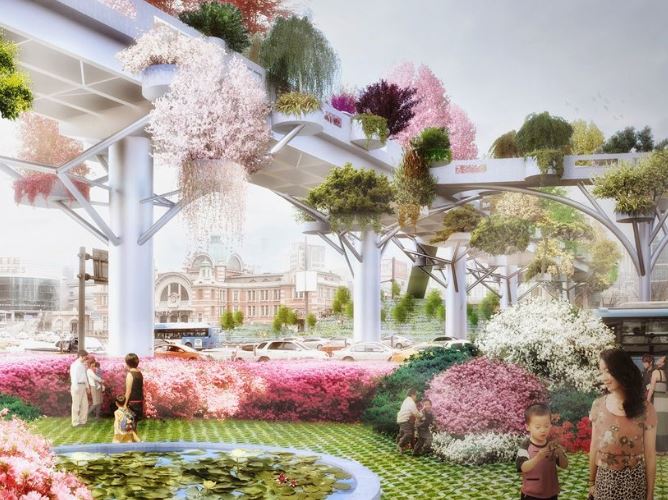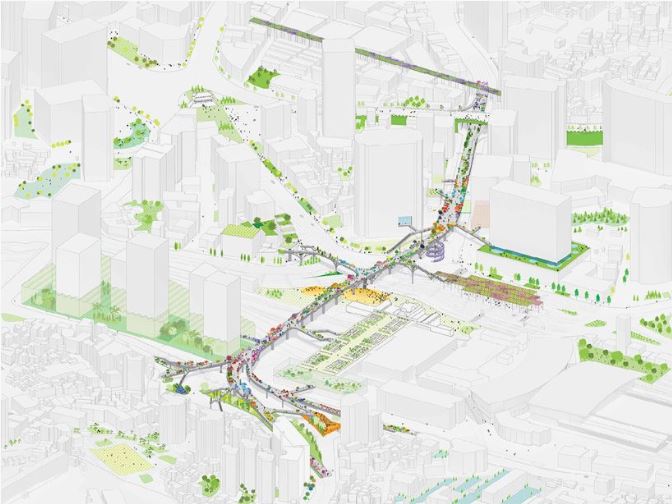[US_Quartz] Seoul’s version of the High Line will have over 24,000 plants ordered alphabetically by name
Seoul’s version of the High Line will have over 24,000 plants ordered alphabetically by name
Quartz By Steve Mallman
See the Original (Click Here)
In 2012, the mayor of Seoul said he wanted to turn an old overpass into an elevated urban park, similar to New York’s iconic High Line. Park Won-soon described the project as a place where “nature and humans can live side by side.”
This month the city government revealed that the park, opening in April, will include over 24,000 plants (including trees) representing over 250 species found in South Korea. The city is spending over $500,000 on the plants, and collecting them from around the nation.
The park will provide not only a stretch of greenery, but also a botanical education—and an orderly one, at that. The plants will be labeled, placed in “neighborhoods” along the overpass, and arranged in (Korean) alphabetical order. Essentially the park will be a “library of the South Korean landscape,” said Bastiaan van der Sluis, a spokesman for Dutch architecture firm MVRDV, which is working on the project.
This month the city government revealed that the park, opening in April, will include over 24,000 plants (including trees) representing over 250 species found in South Korea. The city is spending over $500,000 on the plants, and collecting them from around the nation.
The park will provide not only a stretch of greenery, but also a botanical education—and an orderly one, at that. The plants will be labeled, placed in “neighborhoods” along the overpass, and arranged in (Korean) alphabetical order. Essentially the park will be a “library of the South Korean landscape,” said Bastiaan van der Sluis, a spokesman for Dutch architecture firm MVRDV, which is working on the project.
.JPG)
Dubbed “Seoul-lo 7017″ (the overpass was built in 1970, the park opens in 2017), the park will stretch for about a kilometer. To some it will simply be a shortcut over a busy, not particularly charming part of town dominated by Seoul Station: What would otherwise be a 25-minute walk around the station area will be closer to 10—but that assumes there’s no lingering, which could be hard to resist. Complementing the plants will be cafes, performance stages, street markets, and flower shops.

At night, blue lighting will give the park an otherworldly feel. As MVRDV co-founder Winy Maas explained last November, “You will walk through a flood of blue light as if you’re walking in a cosmos, and all the plants will be lit as if they are the stars, which, they are.”
Overall the project will cost Seoul more than $30 million, causing raised eyebrows among critics. Some accuse the aptly name mayor Park of starting the project to boost his popularity ahead of a presidential run. Park indeed announced a bid for president earlier this month, but he canceled it last week. There’s now speculation he might run for a third term as mayor.
That could bode well for Seoul, a once-dreary metropolis that’s becoming a greener, smarter city. Park has called for restoring the natural beauty of the city’s Han River, and guided the creation of dozens of pedestrian-only streets.
Such efforts build upon the pivotal Cheonggye Stream project, which converted a neglected waterway into one of Seoul’s most popular attractions after its opening as an urban park in 2005 (it also helped then-mayor Lee Myung-bak springboard into the presidency).
Seoul-lo 7017 also looks to the future. Its modular design allows for other green spaces to connect to it, and it will eventually serve as an urban nursery growing plants for other city parks.
Overall the project will cost Seoul more than $30 million, causing raised eyebrows among critics. Some accuse the aptly name mayor Park of starting the project to boost his popularity ahead of a presidential run. Park indeed announced a bid for president earlier this month, but he canceled it last week. There’s now speculation he might run for a third term as mayor.
That could bode well for Seoul, a once-dreary metropolis that’s becoming a greener, smarter city. Park has called for restoring the natural beauty of the city’s Han River, and guided the creation of dozens of pedestrian-only streets.
Such efforts build upon the pivotal Cheonggye Stream project, which converted a neglected waterway into one of Seoul’s most popular attractions after its opening as an urban park in 2005 (it also helped then-mayor Lee Myung-bak springboard into the presidency).
Seoul-lo 7017 also looks to the future. Its modular design allows for other green spaces to connect to it, and it will eventually serve as an urban nursery growing plants for other city parks.
